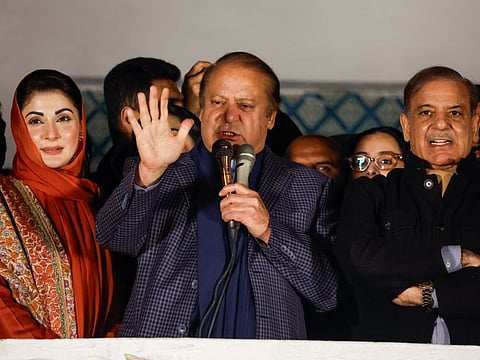Shehbaz Sharif set for Pakistan’s top job as elder brother Nawaz Sharif steps aside
Nawaz does not want to run minority govt having had clear majorities in previous stints

ISLAMABAD: Shehbaz Sharif is set to begin a second term as Pakistan’s prime minister in coming days, returning to the role he had until August when parliament was dissolved ahead of last week’s elections.
Shehbaz, 72, was named by his party and coalition allies to head the nation despite his elder brother and three-time Prime Minister Nawaz Sharif winning a seat in the assembly and being favourite to be sworn in for a fourth term.
Nawaz Sharif’s daughter Maryam said in a post on X that her father did not want to run a minority coalition government having had clear majorities in his three previous stints as premier. Their Pakistan Muslim League-Nawaz (PML-N) party controls only 80 seats in the 264-seat parliament but has been promised support by six other parties for a majority.
The younger Sharif played a key role in keeping together a coalition of disparate parties for 16 months after parliament voted former premier and rival Imran Khan out of office in 2022, and in securing a last gasp International Monetary Fund (IMF) deal in 2023.
Before his stint as prime minister, the younger Sharif was known more as a good administrator than a politician, having served as chief minister thrice in the country’s largest province, Punjab.
But as prime minister, he quickly took on the role of peacemaker between coalition parties often at odds with one another over key policies.
Shehbaz Sharif’s biggest achievement in his short tenure was clinching a bailout from the IMF with Pakistan on the brink of a debt default. The deal was signed after Sharif personally called on IMF chief Kristalina Georgieva last June.
However, under his government, inflation touched a high of 38 per cent with record depreciation of the rupee currency — mainly due to structural reforms necessitated by the IMF programme to stabilise the economy.
He blames the economic meltdown on Khan’s government, which he says broke an agreement with IMF just before he was ousted.
Sharif said his government had to introduce a slew of reforms and scrap subsidies, causing inflation to surge.
KEY CHALLENGES
Pakistan continues to be enmeshed in the economic crisis with inflation remaining high, hovering around 30 per cent, and economic growth slowing to around 2 per cent.
Sharif will need to emulate his feat of securing a short-term IMF bailout with the current programme expiring next month and a new extended deal needed to keep Pakistan on a narrow path to recovery.
Privatising some lumbering state giants, including the national airline, and securing foreign investment will also be key to ease the economic crisis. The Sharifs have close ties with rulers in Saudi Arabia and Qatar, which could help in securing investments in several projects Pakistan has lately showcased for sale.
Sharif will have to juggle relations with the US and China, both major allies.
‘WORKAHOLIC’
Sharif was born in the eastern city of Lahore in a wealthy Kashmiri-origin family that was in the steel business. He started his political career as the chief minister of Punjab in 1997 with a signature “can-do” administrative style.
His cabinet members and bureaucrats who have worked closely with him call him a workaholic.
As chief minister, the younger Sharif planned and executed a number of ambitious infrastructure mega-projects, including Pakistan’s first modern mass transport system in Lahore.
He was caught up in the national political upheaval when his brother was ousted from the premiership by a military coup in 1999 and he went into exile in Saudi Arabia.
Sharif entered the national political scene when he became the chief of the PML-N after the elder Sharif was found guilty in 2017 on charges of concealing assets related to the Panama Papers revelations.
Married twice, Shehbaz Sharif has two sons and two daughters from his first marriage but none from the second. One of the sons is in politics but the others are not in public life.
His second wife is Tehmina Durrani, the well-known author of “My Feudal Lord”, an autobiography about an abusive married life with an earlier husband.
WHAT HAPPENS NEXT?
Pakistan’s president has to convene the inaugural session of the new National Assembly within 21 days of the election, or February 29. Lawmakers are sworn in during that session. They submit nomination papers for a number of key roles, including the speaker and leader of the house. After these positions are filled, a new prime minister is elected through a parliamentary vote, a task that requires a simple majority.
Sign up for the Daily Briefing
Get the latest news and updates straight to your inbox



